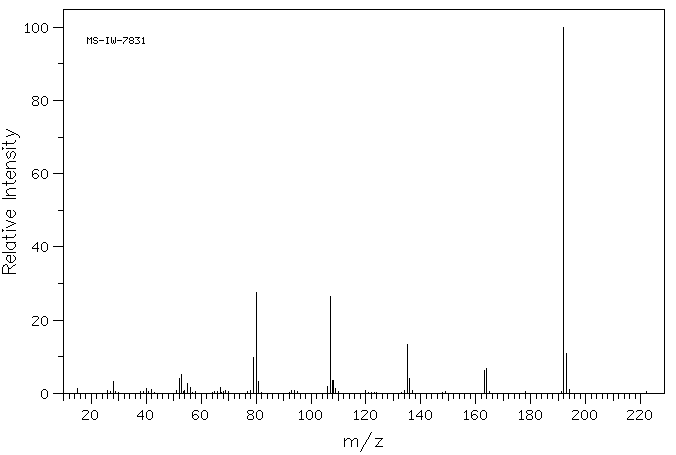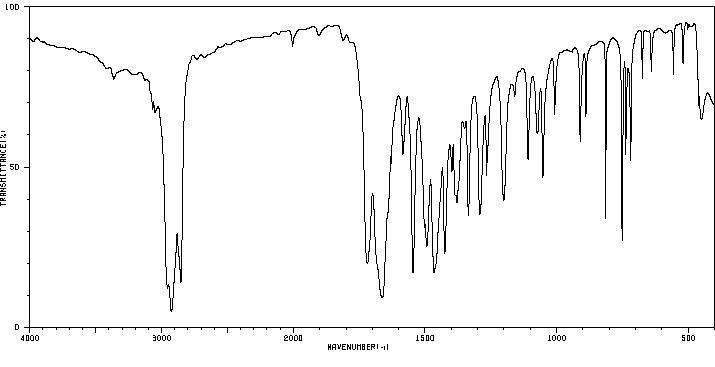1,3-二甲基-2,4(1H,3H)-蝶啶二酮 | 13401-18-8
中文名称
1,3-二甲基-2,4(1H,3H)-蝶啶二酮
中文别名
——
英文名称
1,3-Dimethyllumazine
英文别名
1,3-Dimethylpteridine-2,4-dione
CAS
13401-18-8
化学式
C8H8N4O2
mdl
MFCD02167482
分子量
192.177
InChiKey
LMXZVISHHDYBFW-UHFFFAOYSA-N
BEILSTEIN
——
EINECS
——
-
物化性质
-
计算性质
-
ADMET
-
安全信息
-
SDS
-
制备方法与用途
-
上下游信息
-
文献信息
-
表征谱图
-
同类化合物
-
相关功能分类
-
相关结构分类
物化性质
-
溶解度:0.03 M
计算性质
-
辛醇/水分配系数(LogP):-0.3
-
重原子数:14
-
可旋转键数:0
-
环数:2.0
-
sp3杂化的碳原子比例:0.25
-
拓扑面积:66.4
-
氢给体数:0
-
氢受体数:4
安全信息
-
海关编码:2933990090
SDS
上下游信息
-
上游原料
中文名称 英文名称 CAS号 化学式 分子量 —— 6-chloro-1,3-dimethylpteridine-2,4(1H,3H)-dione 84689-47-4 C8H7ClN4O2 226.622 —— 1-methyl-2,4-dioxo-(1H,3H)pteridine 50256-18-3 C7H6N4O2 178.15 —— 7-(phthalimidomethyl)-1,3-dimethyllumazine 121485-72-1 C17H13N5O4 351.321 —— 1,3-dimethyl-4-iminopteridin-2-one 108175-66-2 C8H9N5O 191.192 —— 4-methoxypteridin-2-one 108175-68-4 C8H8N4O2 192.177 -
下游产品
中文名称 英文名称 CAS号 化学式 分子量 —— 1,3,7-trimethyllumazine 32526-79-7 C9H10N4O2 206.204 7-氨基-1,3-二甲基-2,4(1H,3H)-蝶啶二酮 7-Amino-1,3-dimethyllumazin 7464-70-2 C8H9N5O2 207.192 —— 6-methoxy-1,3-dimethyl-1H-pteridine-2,4-dione 92474-93-6 C9H10N4O3 222.203 —— 7-Ethyl-1,3-dimethylpteridine-2,4-dione 109385-83-3 C10H12N4O2 220.231 —— 6-Tert-butyl-1,3-dimethylpteridine-2,4-dione 109385-81-1 C12H16N4O2 248.285 —— 7-Isopropyl-1,3-dimethyllumazin 94591-37-4 C11H14N4O2 234.258 —— 1,3,6,7-tetramethyl-(1H,3H)-pteridine-2,4-dione 2625-25-4 C10H12N4O2 220.231 —— 7-tert-Butyl-1,3-dimethyllumazin 94591-38-5 C12H16N4O2 248.285 —— 6-Acetyl-1,3-dimethylpteridine-2,4(1H,3H)-dione 94591-18-1 C10H10N4O3 234.214 —— 7-(3'-aminopropyl)-1,3-dimethyllumazine 121485-78-7 C11H15N5O2 249.272 —— 1,3-Dimethyl-7-(2-methylpropyl)pteridine-2,4-dione 109385-84-4 C12H16N4O2 248.285 —— 1,3-Dimethyl-7-pentan-3-ylpteridine-2,4-dione 109385-82-2 C13H18N4O2 262.312 —— 7-acetyl-1,3-dimethylpteridine-2,4(1H,3H)-dione 71014-27-2 C10H10N4O3 234.214 —— 1,3-Dimethyl-6-propionyllumazine 71014-17-0 C11H12N4O3 248.241 —— 6-(1-Hydroxypropyl)-1,3-dimethyllumazin 94591-13-6 C11H14N4O3 250.257 —— 6,7-Diethyl-1,3-dimethyl-1H-pteridine-2,4-dione 109385-86-6 C12H16N4O2 248.285 —— 1,3-dimethyl-7-propionyllumazine 94591-39-6 C11H12N4O3 248.241 —— 6,7-diisopropyl-1,3-dimethyl-1H-pteridine-2,4-dione 50996-18-4 C14H20N4O2 276.338 —— 1,3-Dimethyl-7-piperidin-1-yl-1H-pteridine-2,4-dione 131164-91-5 C13H17N5O2 275.31 —— 6-acetyl-1,3,7-trimethyllumazine 94591-19-2 C11H12N4O3 248.241 —— 7-(phthalimidomethyl)-1,3-dimethyllumazine 121485-72-1 C17H13N5O4 351.321 —— 7-[2-(1,3-Dioxoisoindol-2-yl)ethyl]-1,3-dimethylpteridine-2,4-dione 121485-73-2 C18H15N5O4 365.348 —— 7-[3-(1,3-Dioxo-1,3-dihydro-isoindol-2-yl)-propyl]-1,3-dimethyl-1H-pteridine-2,4-dione 121485-74-3 C19H17N5O4 379.375 —— 6-[1-(1,3-Dioxoisoindol-2-yl)ethyl]-1,3-dimethylpteridine-2,4-dione 121485-76-5 C18H15N5O4 365.348 —— 7-[1-(1,3-Dioxoisoindol-2-yl)ethyl]-1,3-dimethylpteridine-2,4-dione 121485-75-4 C18H15N5O4 365.348 - 1
- 2
- 3
反应信息
-
作为反应物:描述:参考文献:名称:蝶啶衍生物的新合成潜力:在与 C-亲核试剂反应期间直接取代 H 中的 1,3-Dimethyllumazine摘要:蝶啶核是用于大量重要的天然和合成生物活性化合物的杂环支架。许多天然蝶啶参与细胞代谢。因此,具有潜在生物活性的新型蝶啶衍生物的区域选择性合成极为重要[1]。在开发天然和合成生物活性杂环化合物的有效合成方法的过程中,通过 C-亲核试剂直接取代 H 并生产具有 C-C 键的产品,使用 C-H 键的 SN H-官能化 [2, 3] . 据报道,在氧化剂存在下与烷基胺反应,在未取代的 1,3-二甲基咪嗪中发生 Chichibabin 取代 H,得到 7-取代的 1,3-二甲基-2,4-二氧嘧啶-[4,5-b] 吡嗪衍生物。 4]。1的C-6原子,在与醇中的 N-溴代琥珀酰亚胺反应期间,3-二甲基噻嗪被区域选择性地烷氧基化 [5]。使用 C-亲核试剂直接官能化 C-H 键的例子对于 1,3-二甲基lumazine 是未知的。本工作的目标是研究 1,3-二甲基联氨嗪与 C-亲核试剂反应中直接 H 取代的DOI:10.1007/s10600-016-1650-3
-
作为产物:描述:6-chloro-1,3-dimethylpteridine-2,4(1H,3H)-dione 在 manganese(IV) oxide 、 sodium hydrogensulfide 、 碳酸氢钠 、 溶剂黄146 作用下, 以 乙醇 、 水 为溶剂, 反应 99.5h, 生成 1,3-二甲基-2,4(1H,3H)-蝶啶二酮参考文献:名称:蝶啶。Teil LXXX。合成,光化学和哌啶硫磷†摘要:吡啶硫酮的合成,反应和光化学DOI:10.1002/hlca.19860690323
文献信息
-
Immunosuppressive effects of pteridine derivatives申请人:——公开号:US20030236255A1公开(公告)日:2003-12-25Novel poly-substituted pteridinediones (lumazines), and mono- or polysubstituted 2-thiolumazines, 4-thiolumazines or 2,4-dithiolumazines, having disclosed substituents in positions 1, 3, 6 and 7 of the pteridine ring, and pharmaceutically acceptable salts thereof, are useful as biologically active ingredients in preparing pharmaceutical compositions especially for the treatment or prevention of a CNS disorder, a cell proliferative disorder, a viral infection, an immune or auto-immune disorder or a transplant rejection. Combinations of the pteridine derivatives of the invention with an immunosuppressant or immunomodulator drug, an antineoplastic drug or an antiviral agent, providing potential synergistic effects, are also disclosed.
-
HYDROXYL PURINE COMPOUNDS AND USE THEREOF申请人:GUANGDONG ZHONGSHENG PHARMACEUTICAL CO., LTD公开号:US20180148451A1公开(公告)日:2018-05-31Disclosed are a series of hydroxyl purine compounds and the use thereof as PDE2 or TNFα inhibitors, in particular, the compounds as shown in formula (I), or tautomers or pharmaceutically acceptable salts thereof.
-
The syntheses of pteridin-2-one derivatives from diaminomaleonitrile (DAMN)作者:Koichi Tsuzuki、Masaru TadaDOI:10.1002/jhet.5570230508日期:1986.93-dimethylpteridine-2,4-dione, 1-methylpteridine-2,4-dione, 4-alkoxy-1-methylpteridin-2-one, and 4-alkylamino-1-methylpteridin-2-one were synthesized from diaminomaleonitrile (DAMN) through pyrazine-2,3-dicarbonitrile. The synthetic procedures consist of the condensation of DAMN with glyoxal, the nucleophilic substitution of pyrazine-2,3-dicarbonitrile with methylamine, the reaction of 3-methylaminopyrazine-2-carbonitrile
-
Oxotungsten(V) and (VI) complexes of 1,3-dimethyllumazine as models for the tungstopterin cofactor作者:Fridmann M. Hornung、Wolfgang KaimDOI:10.1039/ft9949002909日期:——The coordination of W(O)Cl3 or W(O)2Cl2 to 1,3-dimethyllumazine (DML) occurs at the O(4) and N(5) centres of the chelating DML. While the colourless dioxotungsten(VI) complex shows only partially reversible reduction behaviour, the oxidizable red monooxotungsten(V) complex is stable and could be studied by EPR, UV–VIS, IR and NMR spectroscopy. These latter techniques have been used to confirm the coordination site via changes in the carbonyl stretching bands and via paramagnetic shifts of the proton resonances. Although the EPR results of (L)W(O)Cl3, L = DML, DME (O,O′-coordinating 1,2-dimethoxyethane) and bpy (N,N′-coordinating 2,2′-bipyridine), indicate a rather weak coordination of DML to the Wv centre, the existence of these complexes suggests that the pterin heterocycle coordinates to the metal via N(5) and/or O(4).W(O)Cl3 或 W(O)2Cl2 与 1,3 二甲基哒嗪(DML)的配位发生在螯合 DML 的 O(4) 和 N(5) 中心。无色的二氧钨(VI)络合物只表现出部分可逆的还原行为,而可氧化的红色单氧钨(V)络合物则很稳定,可通过 EPR、UV-VIS、IR 和 NMR 光谱进行研究。后一种技术通过羰基伸展带的变化和质子共振的顺磁移动来确认配位位点。虽然 (L)W(O)Cl3(L = DML)、DME(O,O′配位的 1,2-二甲氧基乙烷)和 bpy(N,N′配位的 2,2′-联吡啶)的 EPR 结果表明 DML 与 Wv 中心的配位相当弱,但这些配合物的存在表明蝶呤杂环通过 N(5) 和/或 O(4) 与金属配位。
-
Synthesis and structural studies on three-dimensionally hydrogen-bonded metal perchlorate complexes with 1,3-dimethyllumazine and 1,3,6,7-tetramethyllumazine. Crystal structure of diaqua-bis(1,3,6,7-tetramethyl-pteridine2,4(1H,3H)-dione-O4,N5) copper(II) perchlorate dihydrate作者:Francisco Hueso-Ureña、Sonia B. Jiménez-Pulido、Miguel N. Moreno-Carretero、Miguel Quirós-Olozábal、Juan M. Salas-PeregrínDOI:10.1016/s0020-1693(97)05722-8日期:1998.2the equatorial plane consisting of two N(5) and two O(4) atoms of pteridine ligands: the two axial sites are occupied by two oxygen atoms from the coordinated water molecules. The monomeric units together with non-coordinated water molecules and perchlorate anions are involved in a complex three-dimensional H-bonds network, the pteridine moieties being packed following planes roughly parallel to b axis在水溶液中,M II(ClO 4)2(MnMn,Co,Ni,Cu,Zn,Cd和Hg)与1.3-二甲基lum嗪9DLM反应)和1,3,6,7-四甲基(嗪(DLMD)(lumazine =(1 H,3 H)-pteridin-2,4-dione)生成通式为Mp II(ClO 4)2(LM)2 · n H 2 O的配合物。技术(元素分析和热重分析),光谱方法(IR,13 C和11 H NMR,UV-VIS-NIR,电子顺磁共振)和磁测量(77–290 K)。对复合物[Cu(DLMD)2(H 2 O)2 ](ClO 4)2 ·2H 2 O进行了单晶X射线衍射研究。该化合物在单斜晶系中结晶。P 2 1 / c空间组,Z = 2,带有和R对于4648个独立反射和224个参数,= 0.0728。金属离子占据中心并表现出扭曲的八面体配位。配位八面体被展平,赤道面由蝶啶配体的两个N(5)和两个O(4)原子
表征谱图
-
氢谱1HNMR
-
质谱MS
-
碳谱13CNMR
-
红外IR
-
拉曼Raman
-
峰位数据
-
峰位匹配
-
表征信息
同类化合物
黄素酰色氨酸
高蝶酸
骏河毒素
酵母粉
诺米林酸17-β-D-吡喃葡萄糖苷
蝶酸
蝶啶3-氧化物
蝶啶-6-基-甲醇
蝶啶-4,6-二胺
蝶啶-2,4-二胺
蝶呤-6-羧酸
苯癸酸,2-羟基-3,4-二甲氧基-6-甲基
苯并[g]蝶啶-4a(2H)-基,5-乙基-3,4,5,10-四氢-3,7,8,10-四甲基-2,4-二羰基-
苯并[g]蝶啶-2,4(1H,3H)-二酮,5-乙酰基-5,10-二氢-1,3-二甲基-
苯并[g]蝶啶-2,4(1H,3H)-二酮,5,10-二氢-7,8-二甲基-
苯并[g]蝶啶-2,4(1H,3H)-二酮,1,7,8-三甲基-
羧甲基黄素
羟基-2-吡啶酮
维生素 B2
维他命 B2
硫酸氢3-(6,7-二氯-2,4-二羰基-3,4-二氢苯并[g]蝶啶-10(2H)-基)-N-乙基-N-(2-羟基乙基)丙烷-1-铵
硫酸氢2-(7,8-二氯-2,4-二羰基-3,4-二氢苯并[g]蝶啶-10(2H)-基)-N,N-二甲基乙铵
甲氨蝶呤钠
甲氨蝶呤杂质1
生物蝶呤-d3
生物喋呤中间体
环己烯,3-氟-4-(甲硫基)-,反-(9CI)
玫瑰黄色素
溴化氢溴化1-(2-氨基乙基)-3-甲基-4-[(Z)-2-萘-1-基乙烯基]吡啶正离子
氯化3-(7-氯-2,4-二羰基-3,4-二氢苯并[g]蝶啶-10(2H)-基)-N,N-二甲基丙烷-1-铵
氨蝶呤钠
氨苯蝶啶
氨甲酸,[(1S)-2-羟基-1-甲基丙基]-,1,1-二甲基乙基酯(9CI)
氨甲蝶呤
氨基蝶呤
核黄素还原
核黄素杂质Q
核黄素5'-硫酸盐
核黄素3′,4′-二磷酸酯
核黄素-4'-磷酸
核黄素-3'-磷酸盐
核黄素,2',3',4',5'-四乙酸酯
核黄素 5'-丁酸酯
核黄素
无色喋呤
异黄蝶呤
己二酸,2-[[4-[[(2-氨基-1,4,5,6,7,8-六氢-4-羰基-6-蝶啶基)甲基]氨基]苯甲酰]氨基]-
左亚叶酸钙杂质
左亚叶酸钙
四氢蝶酰五谷氨酸酯








